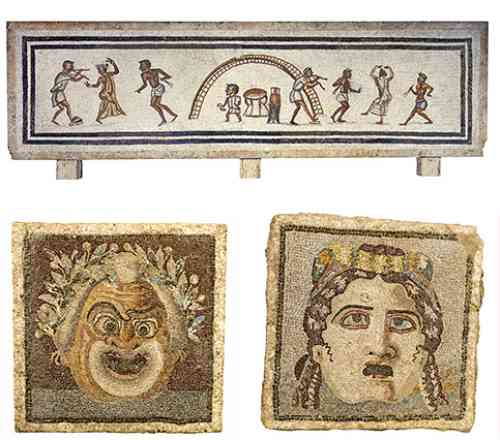▲ Mosaic with dance and mime scene located in the Vatican Museum; emblem with mask of the new comedy, located in Rome, and an emblem with an Etruscan theater mask, found in the Italian capital.Photo courtesy of the Vatican Museums and the National Etruscan Museum of Villa Giulia
Rome. The exhibition Theatre: Authors, actors and audiences in ancient Rome, at the Ara Pacis Museum, curated by Orietta Rossini and Lucia Spagnuolo, concluded with great success and showed the evolution of this performing art through 240 fascinating archaeological pieces. These objects stand out for their uniqueness and rarity, and tell a long history that spans almost a millennium, from their origins in Greece to the fall of the Roman Empire.
According to Aristotle, theater has its origins in Dionysian rituals, of a mystical and comic nature. In Athens, great tragic contests were held during annual festivities in honor of Dionysus, god of wine and fertility, maintaining their characteristics through the use of masks, music, dance and myths that encouraged collective emotional participation. The tragedy was an evolution of the dithyramb, a poetic composition in the form of a choral song dedicated to Dionysus. The orgiastic processions, known as like, They gave rise to comedy, as the name denotes.
The exhibition includes the first known representations of these rituals on Attic cups from the 6th century BC, showing drunken and naked dancers. Highlights a peculiar kylix (cup) illustrating a phallophoria, ritual procession dedicated to the phallus, which concluded the Dionysian festivals, including songs, jokes and obscene scenes.
In this piece, a group of men carry a huge penis with a horse’s head and decorated eyes, symbolizing the transmutation into a Dionysian creature. He is ridden by a grotesque character, with a prominent belly and exaggerated rear, typical accessories of ancient comedy.
Greek theater reached its peak in the 5th century BC, as evidenced by the famous Pronomos vase, a work that represents an ancient theatrical scene with its characters and elements, including Dionysus, his beloved Ariadne and several satyrs. The actors hold their masks, and dancers, musicians and members of the choir can be seen.
The exhibition also emphasizes the enormous loss of ancient theatrical literature: between the 5th and 2nd centuries BC, Greek theater produced some 2,300 comedies, of which 12 have survived (11 by Aristophanes and one by Menander). Of the 312 tragedies attributed to the great classics (Aeschylus, Sophocles and Euripides), only 32 are complete. The situation was even worse for the Hellenistic authors, of whom only names and fragments of their works are known.
Splendor and spectacle
In the Hellenistic era, the terracotta masks found in Tarquinia, in Latium, reflect the profound influence of the Dionysian cult and Greek theater in Etruria, acting as a bridge between Greece and Rome in the transmission of theater, through the Ludions. Etruscans: dancers with music, but without singing. This legacy was enriched by the Atlantean and Fliacian farce of southern Italy, conquered by the Romans, which led Livius Andronicus, a Greek in Rome, to write the first drama in Latin in the year 240 BC, considered the beginning of the Latin literature.
Terracotta vessels and bas-reliefs show theatrical scenes from that time, along with statuettes of masks and actors, which allow the scenes to be visualized.
In republican Rome, Plautus and Terence drew inspiration from Menander and other playwrights of Hellenistic Greek comedy, focusing on everyday and familiar themes rather than political satire. Thus was born the veiled story with Greek characters and settings adapted to Roman comedy, characterized by figures such as the miser, the lovers, the concubine, the parasite, the slave and the cunning servant, among others. The masks of these characters are also exposed.
In Rome, theater was free and accessible to everyone, unlike in Athens. However, political satire was restricted and scripts were controlled by the authorities. The plays were performed mainly on religious festivities and were performed outdoors, during the day, and, until the mid-1st century BC, in temporary structures.
The expansion of the Roman Empire prompted the construction of nearly a thousand theaters throughout the Mediterranean, used by Augustus for political purposes and to achieve social consensus.
From this period, the exhibition includes fragments of frescoes from the dressing room of a theater in Nemi (south of Rome), which allow us to see the props used, such as the costumes, the waxed tablets for writing and the rolls of parchment with the scripts. , among others. Also shown are remains of enormous masks used for Marcello’s theater in Rome, the remains of which are still visible and which show how the secularization
of the theater reduced Dionysian elements, such as masks, to ornamental symbols.
The theater disappeared with the fall of the Roman Empire, being replaced by towns barbarians
without theatrical tradition. Likewise, starting in the 2nd century AD, Christianity attacked this performing art because it was considered a pagan institution; Figures such as Tertullian and Augustine condemned him. Despite this, theater resurfaced in churches, maintaining its religious roots.
Currently, the Syracuse Theater, in Sicily, represents ancient and contemporary works, and authors such as Pasolini have contributed to its renovation.
